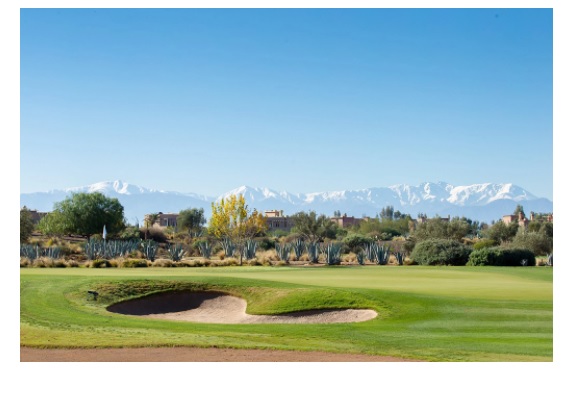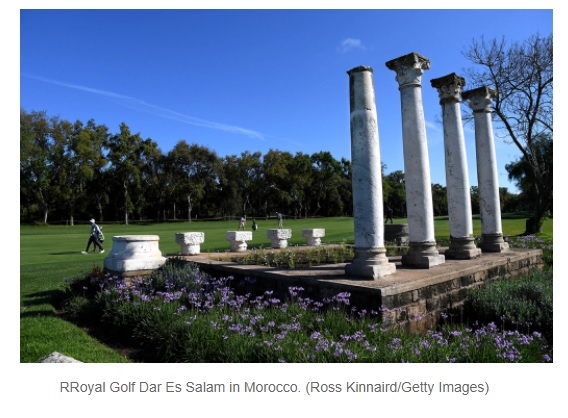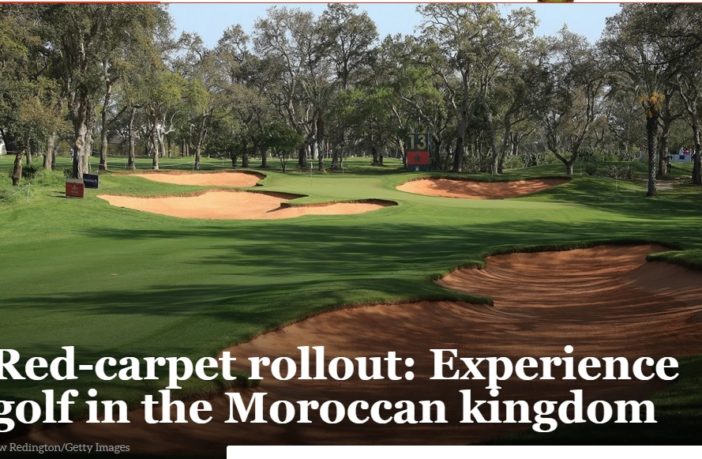Golf Week By Adam Schupak
They rolled out the red carpet for me at Samanah Golf Club in Marrakech. Literally.
Having driven down a Magnolia Lane of olive trees, I arrived at the entrance to the club, where the Morocco Champions, the first PGA Tour-sanctioned stroke-play event to be contested on the continent of Africa, was held Jan. 30-Feb. 1 in the foothills of the Atlas Mountains.
A troupe of Berber tribesman played their darbukas while another countryman dressed in a festive local costume poured me steaming-hot mint tea, the country’s traditional drink of choice, from a silver teapot held high above my painted glass in order to cool the liquid as it fell. Morocco knows how to do a warm welcome.
Located in Northern Africa and separated from Spain by the Straits of Gibraltar, Morocco is the gateway to Europe. The country has a strong European influence, but Morocco also is the entry point to the Arab world, with a deep-rooted respect and tolerance of other religions among a population that is 98 percent Muslim.
Before the coronavirus pandemic led to Morocco closing its borders to tourists for most of 2020, this ancient, mysterious and beautiful country had lured visitors for years. And Morocco is in the midst of a mini-golf boom that has expanded the country’s golf portfolio from a dozen 18-hole courses and five nine-hole facilities 15 years ago to 45 courses at last count. With courses designed by the likes of Robert Trent Jones Sr., Jack Nicklaus, Gary Player and Kyle Phillips, Morocco has its sights set on becoming a magnet for golf tourism when travel restrictions are lifted and golf again beckons to American players looking for adventure.
Adel el Fakir, CEO of the Moroccan National Tourism Office, said that approximately 5,000 to 10,000 American golfers visited Morocco per year before the pandemic, making the U.S. the fifth largest and fastest growing market of Morocco’s 120,000 visiting golfers.
While the first swing in Morocco is believed to have been taken in 1914 in Tangier, the country’s northernmost city, Marrakech, wasn’t far behind. Nine years later, Royal Golf Club in Marrakech was built on the orders of the Pasha. Such eminent figures as Winston Churchill, who liked to paint the snow-clad mountains while relaxing at La Mamounia Hotel, and Dwight D. Eisenhower played here. The course is fairly narrow and winds through cypress, eucalyptus, palm, olive, orange and apricot trees. Located at the feet of the Atlas Mountains, it is a course of extreme beauty and offers a test of shotmaking skills.

Samanah Golf Club (Courtesy of Samanah Golf Club)
The Samanah layout, a Nicklaus Design that opened in 2007, is located a mere five miles from Marrakech’s international airport. It’s a desert-style course with welcoming fairways and virtually no rough when I played it. The greens were tricky but not tricked up. Not long before my visit, the head pro told me he had played the course with Matt Kuchar and his sons, who were on holiday, and Kuchar shot an easy 70, three shy of the then-course record. That mark was shattered during the PGA Tour Champions event, with runner-up Stephen Ames shooting an opening 63 before Brett Quigley won with a 15-under 201.
My scramble team feasted on birdies and then a post-round spread that was a crash course on seemingly every local delicacy. Moroccan cuisine is colorful, sophisticated and artfully presented.
“First, we eat with the eyes,” said El Fakir when we sat down to break bread.
I ate my fill of couscous, the national dish of Morocco, and tagine, a traditional slow-cooked stew braised at low temperatures under a conical lid that traps steam in the eponymous clay dish. The result? Tender meat that falls off the bone with a medley of aromatic vegetables and a complexity of spices along with some combination of olives, quinces, apples, pears, apricots, raisins, prunes, dates or nuts. I also tried mechoui, a meat-lover’s treat of either lamb or sheep with spices such as ras el hanout and saffron cooked in a clay pot over a wood fire. For dessert, there was tray after tray of assorted sweet breads that are typically served with coffee and as mid-day snacks. I piled my plate high and still went back buffet style.
I could have used a nap after all that food but opted to take in a more cultural round of the city’s monuments. From Jemaa el-Fna – Marrakech’s festive, carnival-like nerve center, where on any given day you’ll come across acrobats, magicians and snake charmers – I let my footsteps lead me to one of the city’s many gardens and poked my head in to see the old wash room of the Koutoubia Mosque, where the melodic call to prayer is issued from the mosque five times a day.

Jemaa el-Fna is Marrakech’s festive, carnival-like nerve center, where on any given day you’ll come across acrobats, magicians and snake charmers. (Courtesy of Moroccan National Tourism Office)
Then, it was onwards to explore the bustle of the medina’s maze of alleyways. Colorful, crowded and aromatic, the souks, or markets, are a fascinating assault on the senses. In Marrakech most of the buildings are a shade of salmon, but at sunset the color warms and deepens and seems to blanket the whole cityscape – both from a distance and from within, the city taking on a romantic hue all its own and earning the moniker of the Red City.
Morocco always seemed to be this far off, exotic place, the setting for silver-screen classics like Casablanca, its appeal bolstered by romantic images of riad palaces as the scenes of decadent parties. Its roots are very much in Africa, but its face is turned firmly towards Europe. You can view the Mediterranean Sea and Atlantic Ocean and the snow-capped Atlas Mountains. King Mohammed VI is regarded as a liberal reformer, and the country’s economy is rapidly growing. Yet beneath all the shiny newness, the old Morocco – a land of ancient customs – remains. You may have to search a little harder to find it, but that is half the adventure.
I traveled next to Rabat, the capital city and home to Morocco’s flagship golf facility. Butch Harmon has coached Tiger Woods, Phil Mickelson and Greg Norman, but he jokes he only worked for one guy who had his picture on money.
“You seem to get a lot of good lies when you’re the king,” Harmon says.
Morocco’s King Hassan II, who died in 1999, was a self-professed golf nut, and his fascination with the game led to a course-building boom in the 1970s. He hired 1947 Masters champion Claude Harmon (and later his son, Butch) to teach him the game and befriended Billy Casper, the winner of 51 PGA Tour titles.
In an effort to bridge the cultural divide between Islam and the Western world, his majesty envisioned a golf tournament as a way to transcend cultural prejudices. Casper recommended Robert Trent Jones Sr. design the host venue, saying, “If you want to build a golf course in Morocco, build something to your greatness or don’t build anything at all.”
The Red Course at Royal Golf Dar Es Salam (“House of Peace” in Arabic) winds through a forest of cork, eucalyptus and palm trees, and something you don’t see every day: Roman columns from the ruins of Volubilis, which were relocated to between the 11th and 12th fairways. It makes for one of Jones’ best designs and has hosted the Trophee Hassan II since 1971 and a European Tour stop since 2010. Casper, Payne Stewart, Colin Montgomerie, Bernhard Langer and Erik Compton all were awarded the distinctive bejeweled sword. (A women’s tournament, the Princess Lalla Meryem Cup, runs concurrently on the Blue Course, which Jones protégé Cabell Robinson renovated).

If I didn’t know better, I would have thought I was playing the Dunes Club, another outstanding layout by Jones in Myrtle Beach, South Carolina. The 45-hole Dar Es Salam also includes the nine-hole Green Course. James Duncan, a longtime Coore-Crenshaw associate, undertook what he called “an archaeological exercise” and uncovered Jones’ original plans for the layout in a 600-page file from the Jones archive at Cornell University.
“What struck me about the sketches was how much of the framework for each green had been built per the sketches (in some instances uncannily so) whereas there was little trace of the internal contouring that was referenced in them,” Duncan says. “It was clear that details of many of the greens had not been built per the sketches, either deliberately or by virtue of circumstance.”
He resolved to keep the best of what had been built and to introduce the best ideas from the sketches when possible, converting the green complexes from flat to undulating. The greens are now endlessly fascinating and challenging, which is an accurate description for the course as a whole.

Moroccan cuisine is always colorful, artfully presented and served in abundance. (Courtesy of Moroccan National Tourism Office)
I was starting to doubt whether there was such a thing as a straight putt, but lo and behold my caddie, Mohammed, gave me such a read at the 17th, which Duncan transformed from a long par 3 into a risk-reward, drivable par 4, and Mohammed was right. European Tour Commissioner Keith Pelley recalls South African Dean Burmester approaching him at the 2019 Trophee Hassan II and declaring, “This is the best course we play all year.”
Tucked away to the right of the 10th hole, golfers can see the gardens and grounds of a Ritz-Carlton hotel that is set to open soon. I stayed at the View Hotel, a swanky boutique option less than five miles from the course that offered a breakfast buffet fit for a king and fueled me for the next stop on the journey.
History pervades the air around Meknes Royal Golf Club in the smallest of Morocco’s four great imperial cities. The nine-hole course is a simple back-and-forth design with straightaway holes, but what an experience to play inside the walled gardens of the royal palace in Meknes – the murmur of the mosaic-adorned fountain, the tall sand-colored walls built in the 17th century sheltering a clubhouse with the roofs and minarets of the medina visible in the distance, and the mingled scents of orange, plum and olive trees in its garden are just a few of its charms.
The club was founded in 1969 and is open day and night. His Majesty insisted that floodlights be installed so he could play after dark during the monthlong Islamic holiday of Ramadan. Once, Casper and the king teed off at 11:30 p.m. Casper birded five of the first seven holes, then turned to the king and remarked, “I think I’ve been playing at the wrong time of day.”
Morocco’s newest golf course resides in the resort town of Ifrane, located between Meknes and Fez, where the first Jack Nicklaus Signature Design in North Africa opened in October 2018. (Nicklaus reportedly made five trips.) The cliffside clubhouse at Michlifen Resort and Golf overlooks the adjoining ninth and 18th green with the Atlas Mountains as the backdrop. Yet the course has a parkland feel, as Nicklaus had to work around significant rock outcroppings until the final six holes, which weave through a forest of trees.
But what a finishing kick it is. Coming around a bend between the 16th green and 17th tee took my breath away. The Atlas Mountains reappear for a beauty of a short par 3 at 17 and a par-4 dogleg-left finisher that climbs up the hill toward the clubhouse. Go left on either the tee shot or approach and you might as well dig into your pocket to reload.

The Atlas Mountains attract plenty of alpine adventurers to Ifrane. (Courtesy of Moroccan National Tourism Office)
The alpine resort town of Ifrane is a hideaway nestled in the middle of the mountain range, especially popular among Europeans seeking relief from the summer heat. I stayed down the road from the golf course at the five-star hotel of the same name, which translates to “snow flake,” and is modeled after a luxury ski chalet. It is appropriate to an area tabbed as Morocco’s Little Switzerland and that in winter has a different ambiance as all the town and hotel turn into a winter wonderland.
My last stop took me to Fez, home to two 18-hole courses, the Robinson-designed Royal Golf de Fez and Oued Fez Golf, which has a shiny, new, long-awaited clubhouse. Golfers who enjoy exploring cultures other than their own will be rewarded in the cultural center of Fez. The heart and soul of this medieval town is the medina, where artisans typically have one specialty such as bronze goods and sell one item be it spices, leather goods or perfumes, just to name a few. One vendor sold apricots, dates, almonds and aphrodisiacs that he marketed as “jiggy jiggy.”
The souk is also the perfect place to practice your haggling skills. Vendors can be aggressive, chopping the price of an item in half every time I declined and giving new meaning to the saying he wouldn’t take no for an answer.
There are so many shops that you can get lost amid the narrow streets, and you’re more likely to run into a mule pulling a handcart than a motorized vehicle. This may be the one place that has remained untouched for the last 1,000 years. All that was missing was a magic carpet ride to take me home.
Editor’s note: While we know international travel has ground almost to a halt because of the coronavirus pandemic, it is never too early to start thinking about a “bucket-list” trip in the next few years or to simply dream about golf in a far-off and exotic land.







